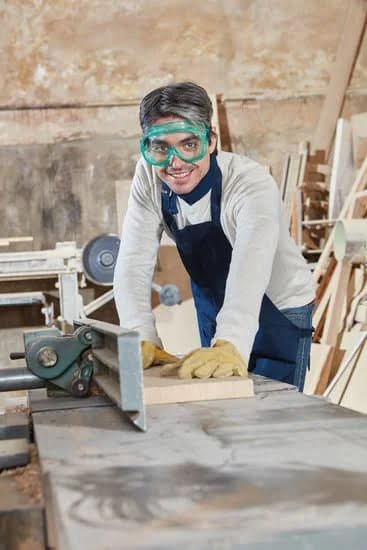Are you interested in learning how to become a fine woodworker? Woodworking is a timeless craft that allows individuals to create beautiful and functional pieces of art with their hands. Whether you’re a beginner or looking to refine your skills, mastering the art of woodworking involves understanding the basics, choosing the right materials, honing essential techniques, and developing precision and attention to detail.
Woodworking is a versatile and fulfilling hobby or profession that involves creating items from wood using specific tools and techniques. From crafting furniture to intricate carvings and DIY projects, woodworking offers endless possibilities for creativity. In this article, we will delve into the world of woodworking and guide you through the essential steps to becoming a fine woodworker.
Understanding the fundamentals of woodworking starts with familiarizing yourself with the necessary tools and materials, selecting the right type of wood for your projects, learning essential techniques, and ultimately refining your skills through practice. Aspiring woodworkers can benefit from expert tips on finishing and polishing their creations, building their portfolio, and finding opportunities within the industry.
Embracing the journey of becoming a fine woodworker involves dedication, patience, and a love for working with this natural material. So let’s begin this exciting journey by exploring what it takes to become an accomplished woodworker.
The Basics of Woodworking
Woodworking is a craft that requires skill, precision, and creativity. Before diving into the art of working with wood, it’s essential to familiarize yourself with the basic tools and materials you’ll need to get started.
Essential Woodworking Tools
To become a fine woodworker, it’s crucial to have the right tools at your disposal. Some essential woodworking tools include chisels, saws, planes, measuring and marking tools, clamps, and a workbench. Understanding how to use these tools properly is fundamental in creating high-quality woodwork.
Understanding Wood Materials
In addition to knowing your tools, understanding different types of wood and their characteristics is also imperative in woodworking. Hardwoods like oak, maple, and cherry are popular choices for furniture-making due to their durability and attractive grain patterns. Softwoods such as pine and cedar are commonly used for structural projects due to their affordability and availability. Familiarizing yourself with the properties of each type of wood will help you select the right material for your projects.
With the knowledge of essential woodworking tools and an understanding of various wood materials under your belt, you’ll be well on your way towards becoming a fine woodworker. However, mastering these basics is just the tip of the iceberg on the journey to honing your craft in woodworking.
Understanding and Choosing the Right Wood for Your Projects
Choosing the right wood is crucial in ensuring the success and quality of your woodworking projects. Different types of wood have varying characteristics, which can greatly affect the outcome of your work. Here are some key points to consider when understanding and choosing the right wood for your projects:
- Wood Species: Familiarize yourself with the different types of wood species available for woodworking. Each type has its own unique grain patterns, colors, hardness, and workability that may suit different projects.
- Project Requirements: Identify the specific requirements of your woodworking project, such as durability, stability, or aesthetics. This will help you determine which type of wood is best suited for the job.
- Budget and Availability: Consider your budget and the availability of different wood species in your area. Some woods may be more expensive or harder to come by, so it’s important to take these factors into account when making a choice.
Understanding how to choose the right wood for your projects is an essential skill for any fine woodworker. By familiarizing yourself with different wood species, considering project requirements, and factoring in budget and availability, you can make informed decisions that will ultimately contribute to the overall quality and success of your woodworking endeavors.
Knowing how to become a fine woodworker also involves learning about working with different woods. With time and experience, you’ll develop a keen eye for selecting the right type of wood for each project, which will set you apart as a skilled artisan in the woodworking industry.
Learning and Mastering Essential Woodworking Techniques
Once you have familiarized yourself with the basic tools and materials used in woodworking, the next step in becoming a fine woodworker is to focus on essential techniques. These techniques are crucial in creating high-quality and polished wood projects.
One of the fundamental woodworking techniques that every aspiring woodworker should learn is joinery. Joinery involves creating strong and seamless connections between pieces of wood. Common types of joinery include butt joints, rabbet joints, dado joints, and dovetail joints. Mastering these techniques will allow you to construct sturdy and visually appealing furniture and other wooden items.
Another vital woodworking skill to develop is the ability to carve and shape wood effectively. This includes using hand tools like chisels, gouges, and carving knives, as well as power tools such as routers and shaping machines. Understanding how to manipulate wood to create intricate designs and smooth surfaces is essential for crafting heirloom-quality pieces.
Additionally, mastering the art of finishing is crucial for bringing out the natural beauty of wood. This involves applying stains, varnishes, oils or lacquers to protect the wood while enhancing its color and grain patterns. Attention to detail during this stage can elevate your woodworking projects from good to exceptional.
| Woodworking Technique | Description |
|---|---|
| Joinery | Create strong connections between pieces of wood for sturdy furniture |
| Carving and Shaping Wood | Use hand tools and power tools effectively to create intricate designs |
| Finishing | Apply stains, varnishes, or oils to protect and enhance the appearance of wood projects |
Developing Precision and Attention to Detail in Woodworking
When it comes to woodworking, precision and attention to detail are crucial skills that every fine woodworker must develop. Whether you are carving intricate designs or crafting seamless joints, mastering these aspects of woodworking is essential for creating high-quality, professional-level projects. Here are some key tips on how to become a fine woodworker by honing your precision and attention to detail:
1. Measure Twice, Cut Once: One of the golden rules in woodworking is to always double-check your measurements before making any cuts. This simple practice can save you from costly mistakes and ensure that your pieces fit together seamlessly.
2. Use High-Quality Tools: Investing in high-quality tools will not only make your work more efficient but also contribute to the precision of your craftsmanship. Sharp blades, accurate measuring tools, and stable work surfaces are all essential for achieving precise results.
3. Pay Attention to Grain Direction: Understanding the grain direction of the wood you are working with is crucial for achieving clean cuts and smooth finishes. Always take note of the direction of the grain when planning out your cuts and shaping your pieces.
These are just a few examples of how attention to detail can make or break a woodworking project. By consistently practicing these habits and incorporating them into your workflow, you can steadily improve your precision and attention to detail as a woodworker.
Practice Makes Perfect
Becoming a fine woodworker takes dedication, patience, and a lot of practice. One essential aspect of honing your craft as a woodworker is to consistently work on different projects that challenge and push your skills to the next level. This not only helps you gain more experience but also allows you to learn from your mistakes and improve with each project.
Another important factor in honing your craft is seeking out feedback from other experienced woodworkers or mentors. Constructive criticism can help you identify areas for improvement and provide valuable insights that can elevate the quality of your work. Additionally, joining woodworking communities or forums can also provide opportunities for learning from others and sharing your own knowledge and experiences.
It’s also crucial to continuously expand your knowledge and skill set by exploring new techniques, tools, and woodworking trends. Whether it’s through attending workshops, taking online courses, or reading books and articles on woodworking, staying updated with the latest industry practices will help you grow as a woodworker. Ultimately, honing your craft is an ongoing process that requires dedication, perseverance, and a passion for creating beautiful and timeless pieces out of wood.
| Aspect | Recommendation |
|---|---|
| Continuous Practice | Consistently work on challenging projects to improve skills. |
| Seek Feedback | Solicit constructive criticism from experienced woodworkers or mentors. |
| Expand Skill Set | Stay updated with new techniques, tools, and trends through workshops, courses, and research. |
Expert Tips for Finishing and Polishing Wood Projects
Invest in Quality Sandpaper and Finishing Materials
One of the most important aspects of finishing and polishing wood projects is using high-quality sandpaper and finishing materials. Investing in good quality sandpaper with different grits will help you achieve a smooth and polished finish on your wood projects. Additionally, using high-quality finishing materials such as varnish, lacquer, or shellac can make a significant difference in the overall look and feel of your finished wood pieces.
Take Your Time With the Finishing Process
When it comes to finishing and polishing wood projects, patience is key. Rushing through the finishing process can result in uneven or streaky finishes, ruining all the hard work you put into crafting your project. Take your time to apply thin, even coats of finish, allowing each layer to dry completely before applying the next one. This will result in a smooth, professional-looking finish that showcases the natural beauty of the wood.
Use Proper Techniques for Applying Finish
Learning how to properly apply finish is crucial in achieving professional-looking results. Whether you are brushing, wiping, or spraying on the finish, it’s essential to use proper techniques to ensure an even application. Understanding how different finishes interact with various types of wood is also important in achieving the desired outcome. By mastering these techniques, you can elevate your woodworking projects to a whole new level.
By following these expert tips for finishing and polishing wood projects, you can enhance the beauty of your woodworking creations and take your skills to the next level. Learning how to become a fine woodworker includes understanding the nuances of finishing and polishing techniques, ultimately leading to stunning finished products that showcase your craftsmanship and attention to detail.
Building Your Woodworking Portfolio and Finding Opportunities in the Industry
As you continue to hone your woodworking skills, it’s important to start building a portfolio of your work. This can include completed projects, as well as any designs or sketches you have created.
A strong portfolio can showcase your abilities to potential clients or employers, providing them with a visual representation of what you can achieve as a fine woodworker. Make sure to photograph your work from different angles and in different lighting to truly capture the craftsmanship and beauty of each piece.
In addition to having a strong portfolio, networking within the woodworking community can open up opportunities for collaboration, mentorship, or even job offers. Attend local woodworking events, join online forums or social media groups dedicated to woodworking, and participate in workshops or classes. Building relationships with other woodworkers can offer valuable insight and support as you continue on your journey of becoming a fine woodworker.
Another way to find opportunities in the industry is by seeking out woodworking competitions or exhibitions. Participating in these events not only provides a chance to showcase your skills but also allows you to connect with potential clients, employers, or suppliers. These opportunities can also serve as a platform for receiving feedback on your work and gaining recognition within the woodworking community.
Overall, building your woodworking portfolio and finding opportunities in the industry requires dedication, perseverance, and an openness to learning from others in the field. Making meaningful connections with fellow woodworkers and actively participating in events can help establish your presence as a skilled craftsman in the industry. Embrace every opportunity for growth and development as you continue on the path towards becoming a fine woodworker.
Conclusion
Becoming a fine woodworker is a journey that requires dedication, patience, and a love for the craft. It is not just about mastering the technical skills and understanding the materials, but also about developing precision and attention to detail in every project. The journey to becoming a fine woodworker involves continuous learning, practice, and honing of one’s craft.
Throughout this article, we have explored the various aspects of woodworking, from its basics to mastering essential techniques and finishing and polishing wood projects. We have also delved into ways to build a woodworking portfolio and find opportunities in the industry. However, the path to becoming a fine woodworker does not end here; it is an ongoing process that requires commitment and passion.
As you embark on your journey to become a fine woodworker, remember that practice makes perfect. Be open to learning from experienced woodworkers, seek out mentorship opportunities, and constantly challenge yourself with new projects. Embracing this journey means being open to making mistakes and learning from them because it is through these experiences that you will truly grow as a woodworker.
In conclusion, becoming a fine woodworker is more than just acquiring technical skills-it is about embracing the artistry of working with wood. By understanding the basics of woodworking, mastering essential techniques, and continuously honing your craft, you can become a skilled artisan in this timeless trade. Stay dedicated, keep refining your skills, and embrace the journey to becoming a fine woodworker-it will be well worth the effort in the end.
Frequently Asked Questions
How Do I Become a Professional Woodworker?
To become a professional woodworker, it’s important to start by learning the basics of woodworking through classes, workshops, or online tutorials. Practice your skills by completing projects and gaining experience in different techniques. Consider pursuing a formal education in woodworking or a related field and seek apprenticeship opportunities with established professionals.
Do Woodworkers Make Good Money?
Woodworkers have the potential to make good money, but it largely depends on their level of skill, experience, and the demand for their work. Experienced woodworkers with a strong portfolio and reputation may be able to command higher prices for their custom pieces or commissioned projects.
Some woodworkers also find success selling their creations through craft fairs, online marketplaces, or their own stores.
How Can I Be a Better Woodworker?
Improving as a woodworker involves continuous learning and practice. Expand your skills by experimenting with new tools and techniques, studying different styles of woodworking, and seeking feedback from experienced woodworkers.
Additionally, pay attention to details, take the time to properly prepare materials, and invest in quality tools and equipment to enhance your craftsmanship. consistently challenging yourself with more complex projects can also help you grow as a woodworker.

Hi everyone! I’m a woodworker and blogger, and this is my woodworking blog. In my blog, I share tips and tricks for woodworkers of all skill levels, as well as project ideas that you can try yourself.





